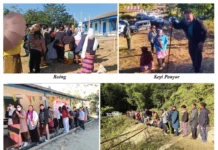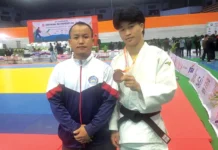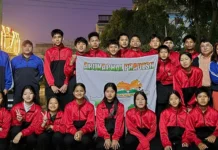On the occasion of the 25th death anniversary of Tomo Riba, perhaps one of Arunachal’s most towering leaders, one looks around and sees that apart from knowing the name of the Tomo Riba Institute of Health and Medical Sciences at Naharlagun that was so generously named after him by the State government, nothing much remains of his life’s story in public memory. As is wont to happen, time makes memories and achievements fade.
And yet, his is a story that needs to be remembered – for he is one of few people to have served in almost all the capacities that one can within a State’s framework- from starting his career as a Field Publicity Officer, to Circle Officer, Anchal Samity Member to being a Chief Minister, Leader of Opposition and Member of Parliament, Tomo Riba’s has been an eventful life journey.
As with many from his generation, the early personal history of Tomo Riba lies hidden in the mists that often blanket the Ego river near Dari where he was born.
All that we would know is that when Tomo Riba, elder son of Rito and Doyum Riba and nurtured in his later life by Yakop Riba, came of schooling age, he was packed off to study firstly in a Venture School established by the Congress at Dipa, in the foothills of what is now Lower Siang and that when he did go off to school, he would be accompanied by a retinue of ‘domestic help’ who would carry his belongings for him and cook for him on the way.
In some sense there was fate hidden in those moments. Because in later life, Dipa, schooling and even the Congress party was something that would affect his life in many more ways.
To return to the narrative, he was to go on to study initially in a missionary school at Sadiya and later at the government Middle School at Pasighat where he would meet many of the friends that shaped his destiny, friends that were to stand by him in his time, and beyond. He would also be influenced and encouraged a lot by his teacher Dulal Hazarika.
He would then pass his matriculation exams from Pasighat, before eventually moving on to study at the St. Edmunds College in Shillong, whichat that time was the seat of governance in the northeast.
It is from here that the mists on his life begin to lift, as we meet people who knew him at that time and who share memories of a striking young man with an infectious smile, and a lot of chutzpah.
In 1959, he would take the first baby steps of a long life in politics…at that moment not too sure-footed, but definitely a reflection of his wanting to make a difference in society. He would become the General Secretary of the Bogum Boka, the apex district council of his tribe and continue to serve it for a good 2 years.
This was also the time when he would marry Harbom Bam from his village, following his childhood betrothal to Yumpu Ropo from the nearby village of Tapo, in keeping with the practiced tradition of child marriage, which he in later life would campaign against.
In 1962, he would make the first of his forays into new grounds, when he would join the services of the Government of India in the Department of Publicity, Ministry of Information and Broadcasting as Field Publicity Officer of Assam, Nagaland and Meghalaya with a posting at Guwahati where he would meet his wife Minoti Bora and eventually get married to her.
Unknown to even him, this stint at the regional hub of the northeast would deeply affect how his life unfolded after. For one, he would meet the leading political luminaries of Assam of the time. This by far would be the turning point of his life. For what he sees and absorbs here in Assam in the next 5-6 years will eventually go on to shape the lines of fate on his palm, metaphorically at least!
In conversations later in life, he would confide about how influenced he was by his meeting stalwarts like Member of Parliament and President of the Assam Pradesh Congress Committee, Lalit Kumar Doley and Mahendra Nath Hazarika, to the extent that many believe that Doley was his real political guru. This is an assertion that becomes difficult to contest because Tomo Riba would live a life much like that of Lalit Kumar Doley- idealistic, driven by a sense of integrity, and to be honest, morally arrogant.
Contrastingly, this was also the time people remember him driving around Guwahati in his jeep- flamboyant, happy and confident, qualities that would see him through the most difficult times of his life.
In 1968, Tomo would hear the call of the land of his birth. Perhaps influenced by the political thinkers he had met in Guwahati, or perhaps just as a way of contributing to his State, he would go on back and join the administration of what was known as NEFA then- the North East Frontier Agency under the Ministry of Home Affairs that foresaw the difficult administration of these “in-hospitable tracts”.
He would join the state services as Circle Officer at Ziro, the headquarter of what was then Subansiri District.
After a tumultuous and much remembered stint as a very strict and often cavalier Circle Officer, at about the age of 38 years, Tomo Riba would make that momentous career shift that would imprint his name in the state’s history. He would contest and win his first of many elections as a Member of the Siang Zilla Parishad and become its Vice President.
From here on, his life and the life of his beloved State would go on a political, social and developmental roller coaster ride unparalleled in history. NEFA would go on to become the Union Territory of Arunachal Pradesh, and later much to Riba’s disagreement, a State of the Union of India. This long drawn process would be filled with the drama of uncertainty, of insecurities and of successes too.
On Oct 6 1972, along with first generation leaders Tadar Tang, Sobeng Tayeng, PK Thungon, Wangpha Lowang he would be called on to become Executive Member / Councillor of the Arunachal Pradesh Legislative Council once it became a Union Territory on 20 January 1972. He would then continue as a Councillor and also represent the State as Chief Councillor at the pioneering meeting of the North East Council at Shillong.
When in 1975, the Pradesh Council would be converted into the Provisional Legislative Assembly of Arunachal Pradesh, he would go on to be appointed as Minister of key departments like Public Works, Planning, Rural Works, Information and Public Relations and Panchayat, Agriculture, Horticulture and by far his pet arena of interest- Animal Husbandry.
The years that followed were, to say the least, tumultuous for the young electoral democracy that the State had become. Many political developments would take place that would shape the destiny of the land as we live in today. This was also the time that he would eventually resign from the Council of Ministers of the Provincial Assembly and join the newly formed People’s Party of Arunachal Pradesh. This would sow the seeds of an argument for regionalism in politics that went on to define the entire northeast region.
The first-ever Assembly elections in the State, held in February 1978 gave him the opportunity to become the 2nd Chief Minister of Arunachal Pradesh on 19th September 1979 as the leader of the People’s Party of Arunachal (PPA) in a series of politically charged events. However, because of defections from the PPA to the Congress, his ministry became a minority, and he recommended to the Lt. Governor to dissolve the Assembly and chose to face new elections.
Following this, he was elected as Member of the 2nd Legislative Assembly in the elections of 1980 and would spend arguably the most remembered part of his life as Leader of the Opposition in the Assembly; a role many say suited not just his oratory but also his ability to point out the shortcomings in policy and failings in development initiatives. This would be the image that would remain in the minds of his colleagues and his followers- that of a firebrand messiah out to champion his vision of balanced and equitable growth.
The People’s Party of Arunachal would eventually merge with a national Party, the Janata Dal in a bid for survival, though not legitimacy. He would head both avatars of the outfit as President and lead it through its most difficult moments.
In 1995, he would be elected back again to the State Legislative Assembly as an Independent candidate where he would be made Pro-Tem Speaker, scuttling any chance of other positions being offered to him. Here, he would serve on different key committees of the House.
It would be left to an issue that he would often confront the central Govt many times over that would catapult him into the Parliament of India in 1996. This was when he would contest from the Western Parliamentary Constituency and win again as an Independent candidate on the issue of the settlement of Chakma and Hajong refugees in the State.
It would be in Delhi that he would spend the last few years of his active political life and when the NDA government would fall and re-elections held, he would lose the elections and return home to his residence in Naharlagun.
Fatefully, this would also be when he would spend a lot of time with family and relatives, imaginably in making up for when he could not afford to be present, swept away as he was with the demands of an active political life. Along with his family, the plants in his garden too would benefit from the love and nurturing that he would showeron them.
He would eventually fall victim to his illness and after a brief hospitalization at the Ramakrishna Mission in Itanagar and later at the Downtown Hospital in Guwahati, the legend that was Tomo Riba, would expire in the early hours of 16 February 2000.
After a State Funeral at his residence at Naharlagun, his body would travel to bid adieu to his many believers and Party workers, and be eventually buried at New Dari, home finally.
Today, as he lies in his grave, back in the land he was born- listening to the familiar whisper of the Ego river, the whistling cold winds that blow across the valley and the oft familiar sounds of women and children coming back from the hilly jhum fieldsflanking the village, it is difficult to say what must be in his thoughts.
For, while he did live a full life achieving almost every position in the chosen field that he took up, from being a Panchayat leader to being a Chief Minister and even representing the State in the stately halls of the Lok Sabha- yet, when his time came, his was an abrupt end, like a poem left mid stanza. He still had dreams to build, lives to change, better histories to write perhaps.
That of course is not to be. But what will be is that when he was here, like the ballads that are sung in his land of wise men past, he did make a difference not to his own life perhaps, but to countless others. That will remain.
And as he lies there in his shroud of incompleteness, a verse comes to mind of a card placed with a wreath on his grave 25 years ago, in the language of his ancestors, which reflects the same directness and candour with which he lived his life:
Tomo Riba No
Tani Mokom Epak Torela
Ui Moko Lo Yeken Be
Yeyin Laka
Tomo Riba
Having Left This Land of The Living
Fare Thee Well
In The Land Where Spirits Roam Free.
Fare thee well, Tomo Riba. You are remembered. And missed.
(The feature is an excerpt from the book One Tale, Two Stories on the life of Tomo Riba, published by the Tomo Riba Memorial Trust)



